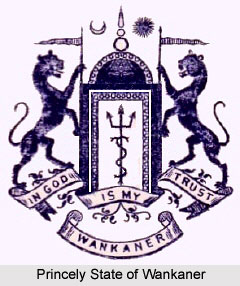 The Princely State of Wankaner was under the reign of the senior branch of the Jhala Rajputs that was incorporated as a part of the Baroda Agency in the Western India States Agency. Later it became a part of the state of Gujarat. The princely state covered a total area of 417 sq m and also included the erstwhile taluka of Mesaria. The territory comprised of a total population of 54,965 in the year 1941. The princely state of Wankaner was located in north-western Kathiawar and included a total of one hundred and four villages, excluding the talukdari village of Khasta in Ahmedabad. The Wankaner state was bounded by Dhrangadhra and Morvi in the north; by Lakhtar in the east; by Chotila, Bamanbor and Rajkot in the south; and Kotda and Morvi in the west.
The Princely State of Wankaner was under the reign of the senior branch of the Jhala Rajputs that was incorporated as a part of the Baroda Agency in the Western India States Agency. Later it became a part of the state of Gujarat. The princely state covered a total area of 417 sq m and also included the erstwhile taluka of Mesaria. The territory comprised of a total population of 54,965 in the year 1941. The princely state of Wankaner was located in north-western Kathiawar and included a total of one hundred and four villages, excluding the talukdari village of Khasta in Ahmedabad. The Wankaner state was bounded by Dhrangadhra and Morvi in the north; by Lakhtar in the east; by Chotila, Bamanbor and Rajkot in the south; and Kotda and Morvi in the west.
The Princely State of Wankaner was honoured as one of the salute states of India with a gun salute of 11 guns. The courts of the state exercised full civil and criminal jurisdiction. The manager of the state was known as Karbhari and was entrusted with the administration of the state. Wankaner state was ranked in the 13th position in order of precedence among the states of Western India, between Palitana and Jafrabad. The Indian princely state of Wankaner paid tribute to the state of Junagadh. The native ruler of Wankaner state held the hereditary title of Maharana Raj Saheb, since the year 1934.
The Jhala Rajputs were the ruling family of Wankaner state. After the death of the founder of the Jhala kingdom, Thakore Chandrasinghji of Halvad Dhrangadhra, Ashkaranji, his 2nd son, seized the royal throne or gadi to the disadvantage of Rajolji and Sartanji, sons of his late eldest brother Prithiraji and also his nephews. The brothers were supported by the Jam Sahib of Nawanagar and fought and obtained the state of Wankaner from the savages and established an autonomous kingdom in the year 1630. Later Rajoji, his younger brother, founded the state of Wadhwan.
After the nation became independent in the year 1947, the princely state of Wankaner was acceded to the newly formed Union of India. It was later incorporated with the other Indian princely states in the territories to create the Saurashtra Union in June 1948.



















